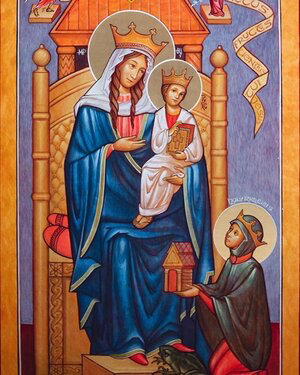Text from The Saint Andrew Daily Missal,
unless otherwise stated.
Thursday after Ash Wednesday.
Station at Saint George's (San Giorgio-in-Velabro).
Indulgence of 10 Years and 10 Quarantines.
Violet Vestments.
Photo: April 2006.
Source: Own work.
Author: User: Zello
(Wikimedia Commons)
This Station is, since the time of Pope Gregory II (7th-Century A.D.), at Saint George's-in-Velabro. This Church is in the district called The Velabrum, or Velum aureum, on account of a Relic kept in a Golden Veil. Saint George's is one of the twenty-five Parishes of Rome in the 5th-Century A.D., where, under The High Altar, is kept the Head of this Christian warrior, a victim of The Persecution of The Emperor Diocletian, and called by the Greeks "The Great Martyr".
The Liturgy of today inculcates in us the spirit of Prayer, which forms part of The Forty Days' Penance. It was by Prayer that Ezechias obtained a prolongation of his life (Epistle of today) and the Centurion the healing of his servant (Gospel), and it is by Prayer that we shall obtain from God the strength to mortify ourselves, in order that we may gain the pardon of our sins, and, with it, the healing of our Souls and Life Eternal.
San Giorgio-in-Velabro.
Photo: August 2012.
Source: Own work.
Author: Luc
(Wikimedia Commons)
The Gospel, in former times, reminded the Catechumens that, through Baptism, they were about to enter The Kingdom of Heaven.
Remember that, if sin offends God and draws upon us the scourge of His Righteous Anger, Penance, on the contrary, appeases Him and procures for us the effects of His Mercy (Collects).
Mass: Dum clamárem.
Preface: For Lent.
San Giorgio-in-Velabro.
Photo: March 2012.
Source: Own work.
Author: sailko
(Wikimedia Commons)
The following Text is from Wikipedia - the free encyclopædia.
San Giorgio-in-Velabro is a Minor Basilica Church in Rome, Italy, Devoted to Saint George.
The Church is located in the ancient Roman Velabrum, near the Arch of Janus, in the rione of Ripa. Sited near The River Tiber, it is within a complex of Republican-era pagan temples associated with the Port of Rome. The ancient Arcus Argentariorum is attached to the side of the Church's façade.
San Giorgio-in-Velabro is The Station Church for The First Thursday in Lent.
The first religious building attested, in the place of the current Basilica, is a Diaconia, funded by Pope Gregory the Great.
The High Altar,
San Giorgio-in-Velabro.
Photo: March 2012.
Source: Own work.
Author: sailko
(Wikimedia Commons)
The current Basilica was built during the 7th-Century A.D., possibly by Pope Leo II, who Dedicated it to Saint Sebastian. A 482 word-inscription in the catacombs of Saint Callixtus probably refers to a Church in the same zone. Its plan is irregular, indeed slightly trapezoidal, as a result of the frequent additions to the building. The Interior Columns are almost randomly arranged, having been taken from sundry Roman temples.
The Basilica was inside the Greek Quarter of Rome, where Greek-speaking merchants, civil and military officers, and Monks, of The Byzantine Empire lived — the nearby Santa Maria-in-Cosmedin, for example, was known as Schola Graeca at the time. Pope Zachary (741 A.D. - 752 A.D.), who was of Greek origin, moved the Relic of Saint George to this Basilica from Cappadocia, so that this Saint had a Basilica Dedicated in The West, well before the spreading of his Devotion associated with the return of The Crusaders from The East.
After a restoration by Pope Gregory IV (9th-Century A.D.), the Basilica received the addition of the Portico and of the Bell-Tower in the first half of the 13th-Century. The Apsis was decorated with frescoes by Pietro Cavallini in the 13th-Century.
Photo: April 2007.
Source: Own work.
Author: Lalupa
(Wikimedia Commons)
Between 1923 and 1926, the Superintendent of Monuments of Rome, Antonio Muñoz, completed a more radical restoration programme, with the aim of restoring the building’s “Mediæval character” and freeing it from later additions. This was done by returning the floor to its original level (and so exposing the Column bases), re-opening the ancient windows that gave light to the Central Nave, restoring the Apsis, and generally removing numerous accretions from the other most recent restorations. During this process, fragments (now displayed on the Basilica's Internal walls) were found, indicating a schola cantorum on the site, attributed to the period of Pope Gregory IV.
The building, as we see it today, is largely a product of the 1920s’ restoration. However, five years' further restoration followed the explosion of a car bomb, parked close to the Basilica's facade, at midnight on 27 July 1993. That explosion caused no fatalities but left the 12th-Century Portico almost totally collapsed and blew a large opening into the wall of the main Basilica, as well as doing serious damage to the residence of The Generalate of The Crosiers (Canons Regular of The Order of The Holy Cross), next door.
The Ministry of Cultural Heritage researched and catalogued what was damaged or destroyed, placing the fragments in 1050 crates, with dates and locational references, before restoring the building with them, although some details, particularly in the Portico, were deliberately left un-restored as a memorial to the bombing.
Gianfranco Ravasi is, since November 2010, Cardinal-Deacon of the Church. Among the previous Titulars are: Oddone Colonna, who later became Pope Martin V; Raffaele Riario; Giacomo Stefaneschi; and John Henry Newman. Cardinal Alfons Maria Stickler was Titular of San Giorgio, as a Cardinal Priest, until his death in 2007.






























